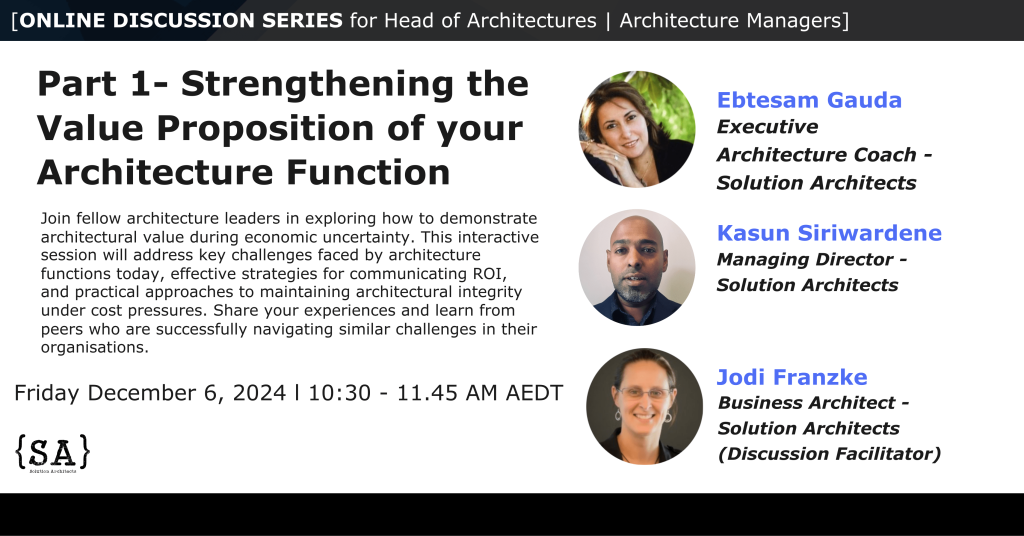
Key Insights explored throughout the session:
Participant views underscored that the challenges and pain points in articulating and demonstrating the value of architecture are shared across organisations, regardless of industry or size.
- Struggle of Alignment of architectural touch points into the Agile project delivery framework. How does the Governance work in an Agile environment?
- Success and value behind Application Portfolio Management.
- Alignment of objectives between Project Managers and Architecture.
- Balance between pragmatic architecture and strategic architecture.
- Architects are seen as blockers, slowing down the process.
- Architects need to get out there and speak to the business. Introduce what architects do for the business.
- The business’ first engagement for the architect should not be the Governance or hammer when “something can’t be done”.
- “Markitecture” – the act of effectively marketing architectural guardrails.
- Have the reference architecture/principles endorsed.
- Application software listed as key input into the governance.
Common pain points hindering the value proposition of Architecture:
Strategic Challenges
- Alignment with Business Goals:Difficulty aligning architectural initiatives with dynamic business strategies.
- Proving Value: Demonstrating tangible benefits of architecture, especially in cost-sensitive environments.
- Adapting to Rapid Change: Keeping pace with evolving technologies, competitive pressures, and market demands.
Operational Challenges
- Managing Complexity: Simplifying and overseeing intricate IT landscapes with a mix of legacy and modern systems.
- Resource Constraints: Addressing shortages in skilled personnel, time, or budgets for architectural initiatives.
- Fragmentation and Silos: Tackling inconsistencies in processes, tools, and practices across departments.
Governance and Compliance
- Governance Gaps: Ensuring governance frameworks align with organisational models and effectively address regulatory needs.
Collaboration and Communication
- Stakeholder Engagement: Securing buy-in from business leaders, IT teams, and other stakeholders.
- Cross-Team Collaboration: Ensuring smooth coordination across diverse teams and external partners.
Technical Challenges
- Integration Complexities: Achieving seamless integration of diverse systems and technologies.
- Scalability and Performance: Designing architectures that grow efficiently while maintaining performance.
- Managing Technical Debt: Modernizing legacy systems while maintaining operational continuity.
Innovation and Agility
- Balancing Innovation and Stability: Supporting new initiatives while ensuring reliability.
- Adopting Emerging Technologies: Leveraging innovations without complicating architectural designs.
Cultural and Organisational Challenges
- Resistance to Change: Overcoming hesitation toward adopting new practices and technologies.
- Addressing Skill Gaps: Bridging gaps in expertise, particularly in areas like cloud computing, microservices, and DevOps.
Metrics and Reporting
- Measuring Success: Defining and tracking meaningful KPIs to assess architectural impact.